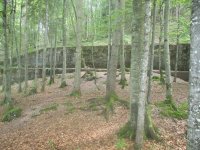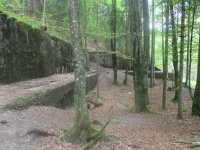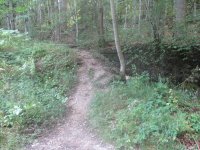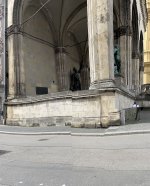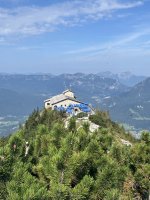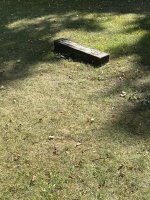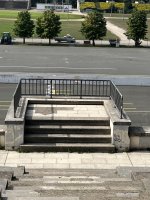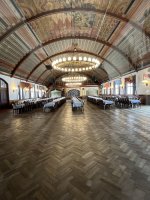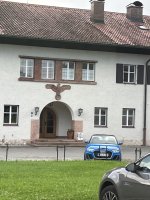Combat
Brigadier General
- Joined
- Jun 10, 2005
- Messages
- 10,991
I just returned from a couple of weeks in Germany where I had a chance to visit several of the WWII-related locations. I'll try to post some pictures but my observations starting with Berlin:
Berlin
New & Old Reich Chancellery: The enormous Reich Chancellery complex has been completely erased from existence. Replaced with apartments, office buildings, and store fronts. I had dinner at a Chinese restaurant that would have been located approximately between the entrance of the New Reich Chancellery and the interior courtyard. Surreal to think that Hitler's thousand-year Reich has been replaced by a series of Asian restaurants.
Fuhrer bunker: Just behind the buildings that have replaced the Old Chancellery is the location of Hitler's bunker where he met his demise. It's now a parking lot for an ordinary apartment complex. Other than the groups of tourists standing around it would be impossible to know that anything had ever happened there.
Reichstag: The exterior of the building is magnificent. Iconic. Unfortunately, the interior has been completely remodeled in a horrific modern way that is ghastly. My assumption is that the Germans did this intentionally to avoid any link to the Nazi era believing, erroneously in my opinion, that the more classic architecture is linked to that era. The roof top, however, is magnificent. Fantastic views. One of the great things about visiting the actual locations is that you gain a new perspective. I always assumed that the iconic photo of the Soviets raising the flag over the Reichstag was taken at the front of the Reichstag facing the Tiergarten in the direction from which the Russians stormed the building. After walking around the roof, however, and matching it to the photo it appears that the flag was raised on the backside of the Reichstag facing downtown Berlin.
Brandenburg Gate: I stayed at the Hotel Adlon just adjacent to the gate. Iconic. Napoleon came through the gate in the 1800s. In stark contrast to the WWII era images of swastika flags hanging from the gate as thousands of torch bearing SA marched through the gate, there was a pro-Israel rally going on there last week.
Anhalter Bahnhof: The only thing that remains of the great train station after it was bombed and then razed is the exterior entryway. A short walk away is a "bunker" museum that can be toured. That bunker housed several thousand Germans during the battle of Berlin.
Invalids Cemetery - Final resting place of many historical Prussian and Nazi era figure including Schanhorst, Udet, Todt, and most infamously Reinhard Heydrich. Heydrich is buried in an unmarked grave. Several years ago someone tried to dig it up. Very chilling to be standing at the grave of the architect of the Holocaust. The more that you learn about the pre and early war years, the more that you discover that Heydrich was involved in the planning of almost every major event.
Goring's Air Ministry - Ironically one of the few WWII-era buildings to survive bombing. It's now an austere looking government finance building. The SS/Gestapo HQs on the notorious Prinz-Albrecht Strasse is just a block away. It is completely gone but there is a sort of museum there that can be toured.
Berlin
New & Old Reich Chancellery: The enormous Reich Chancellery complex has been completely erased from existence. Replaced with apartments, office buildings, and store fronts. I had dinner at a Chinese restaurant that would have been located approximately between the entrance of the New Reich Chancellery and the interior courtyard. Surreal to think that Hitler's thousand-year Reich has been replaced by a series of Asian restaurants.
Fuhrer bunker: Just behind the buildings that have replaced the Old Chancellery is the location of Hitler's bunker where he met his demise. It's now a parking lot for an ordinary apartment complex. Other than the groups of tourists standing around it would be impossible to know that anything had ever happened there.
Reichstag: The exterior of the building is magnificent. Iconic. Unfortunately, the interior has been completely remodeled in a horrific modern way that is ghastly. My assumption is that the Germans did this intentionally to avoid any link to the Nazi era believing, erroneously in my opinion, that the more classic architecture is linked to that era. The roof top, however, is magnificent. Fantastic views. One of the great things about visiting the actual locations is that you gain a new perspective. I always assumed that the iconic photo of the Soviets raising the flag over the Reichstag was taken at the front of the Reichstag facing the Tiergarten in the direction from which the Russians stormed the building. After walking around the roof, however, and matching it to the photo it appears that the flag was raised on the backside of the Reichstag facing downtown Berlin.
Brandenburg Gate: I stayed at the Hotel Adlon just adjacent to the gate. Iconic. Napoleon came through the gate in the 1800s. In stark contrast to the WWII era images of swastika flags hanging from the gate as thousands of torch bearing SA marched through the gate, there was a pro-Israel rally going on there last week.
Anhalter Bahnhof: The only thing that remains of the great train station after it was bombed and then razed is the exterior entryway. A short walk away is a "bunker" museum that can be toured. That bunker housed several thousand Germans during the battle of Berlin.
Invalids Cemetery - Final resting place of many historical Prussian and Nazi era figure including Schanhorst, Udet, Todt, and most infamously Reinhard Heydrich. Heydrich is buried in an unmarked grave. Several years ago someone tried to dig it up. Very chilling to be standing at the grave of the architect of the Holocaust. The more that you learn about the pre and early war years, the more that you discover that Heydrich was involved in the planning of almost every major event.
Goring's Air Ministry - Ironically one of the few WWII-era buildings to survive bombing. It's now an austere looking government finance building. The SS/Gestapo HQs on the notorious Prinz-Albrecht Strasse is just a block away. It is completely gone but there is a sort of museum there that can be toured.


